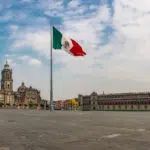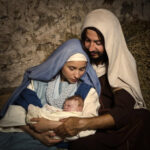Las Posadas, celebrated yearly from December 16-24, is a religious festival traditionally held in Mexico and parts of Latin America. Translating to ‘The Inns’ in Spanish, Las Posadas is an important part of the Christmas festivities. Over the nine nights of celebrations, parties are held at different people’s homes. Before each gathering, all the guests form a procession to mark Mary and Joseph’s search for an inn on the night of Jesus’s birth. The march is usually led by an angel as a symbolic act of Mary and Joseph finding shelter in a stable when they were unable to find lodging in Bethlehem. The parties are joyous occasions, including prayers, food, music, fireworks, and piñatas!
History of Las Posadas
Now a widely-celebrated tradition throughout Latin America, there is evidence that Las Posadas originated in colonial Mexico. The Augustinian friars of San Agustin de Acolman, near Mexico City, are believed to have organized the first posadas. In 1586, Friar Diego de Soria, the Augustinian prior, obtained a papal bull from Pope Sixtus V to celebrate what was called ‘Misas de Aguinaldo’ or ‘Christmas bonus masses’ between December 16 and 24.
The tradition seems to be one of many examples of how the Catholic religion in Mexico was adapted to make it easier for the indigenous people to understand and blend with their earlier beliefs. The Aztecs had a tradition of honoring their god Huitzilopochtli at the same time of year, coinciding with the winter solstice.
The Posada celebrations were originally held in the church but the custom spread. Later it was celebrated in haciendas, and then in family homes, gradually taking the form of the celebration as it is now practiced by the time of the 19th century. Now, neighborhood committees often organize the posadas and a different family will offer to host the celebration each night. The other people in the neighborhood bring food, candy, and piñatas so that the costs of the party don’t fall only on the host family.
Adults, including musicians, follow the procession, which visits selected homes and asks for lodging for Joseph and Mary. Traditionally, the procession is always refused lodging, though the hosts often provide refreshments. At each stop, passages of scripture are read and Christmas carols are sung.
Mass is held each day after the procession and, after the service, children break open piñatas filled with candy, toys, and occasionally money. The piñatas are usually crafted in the form of a star, which is said to have guided the three wise men of Biblical tradition to the newborn Jesus.
Las Posadas timeline
The Aztecs, particularly Mexica or a group of Nahua people entering Central Mexico founding the Aztec Empire, traditionally worshipped Huitzilopochtli, the god of war, during the winter solstice.
The winter solstice festival, which was one of the most important celebrations of the year to the Aztecs, is proselytized when Spanish missionaries brought the reinvented religious pageant to Mexico to teach the story of Jesus' birth.
Friar Diego de Soria, the Augustinian prior, obtains a papal bull from Pope Sixtus V to celebrate what was called ‘Misas de Aguinaldo.’
A large procession of Las Posadas begins along the San Antonio River Walk, traversing large landmarks in Texas — including the Arneson River Theater, Museo Alameda, and the Spanish Governor's Palace, ending at the Cathedral of San Fernando.
Las Posadas FAQs
How long do Las Posadas last?
One of the most popular Christmas traditions in Northern New Mexico is Las Posadas, a nine-day celebration of religious observance beginning December 16 and ending December 24th. The ritual has been a tradition in Mexico for over 400 years.
Who participates in Las Posadas?
So here is the religious story behind Las Posadas. Las Posadas is a tradition brought to Latin America by the Spanish and adopted in both Mexico and Guatemala. Starting December 16th at dusk, families, friends, and neighbors dress up as angels and shepherds. Two people are dressed as Mary and Joseph, as well as the innkeeper.
What do you eat on Las Posadas?
After the piñata comes dinner. Traditional posada fare is tamales, buñuelos, atole, and café de olla. The tamales are made with corn dough, softened with lard, and beaten until the dough reaches ‘water stage’ — a small ball of dough should float when put in a glass of water; if it sinks, it needs to be beaten more.
How To Celebrate Las Posadas
Make star-shaped piñatas
Las Posadas is a great event that can be celebrated by adults and children alike! One of the most exciting elements of Las Posadas is the star-shaped piñatas filled with candy and toys. Children often take turns to put on a blindfold and hit the piñata with a stick and once it breaks everyone will rush in to grab a handful of tasty treats. But you don’t have to be a child to hit the piñata, fill one for yourself and try it with family and friends who are Mexican or Catholic.
Attend a procession
Before each gathering, all the guests form a procession to mark Mary and Joseph’s search for an inn on the night of Jesus’s birth. The march is usually led by an angel, guiding Mary and Joseph to shelter, when they could not find one in Bethlehem. The participants will first hold candles and sing Christmas carols, and make their way to a particular home. A special song ‘La Canción Para Pedir Posada’ is sung, until the host agrees to let everyone inside. It’s a time of celebration but also a remembrance of Mary and Joseph’s miraculous journey.
Reflect and meditate
On each of the nine nights, a different quality will be meditated upon — humility, strength, detachment, charity, trust, justice, purity, joy, and generosity. Before indulging in delicious food and beverages such as tamales and ‘ponche’ or ‘atole,’ consider reflecting upon important spiritual qualities that help us become better humans, no matter what you believe in.
5 Amazing Facts About Las Posadas
The seven deadly sins
The star-shaped piñata children break apart has seven points that are meant to symbolize the seven deadly sins.
Rewards from heaven
The treats released from inside the piñata symbolize rewards from heaven, which are shared among guests in packages called ‘aguinaldos.’
Staying warm and cozy
To stay warm, guests are served ‘ponche’, an aromatic fruit punch that includes piloncillo, water, cinnamon, and fruits such as guavas, tejocotes, and oranges.
Mary’s birth symbolized
The ‘Novena’ — the nine days of Las Posadas — signifies the nine months Mary carried Jesus in her womb.
Songs of devotion
The songs that are sung at each home form a dialogue between the ‘Fuera,’ sung by the pilgrims, and ‘Dentro,’ sung by those playing the innkeepers.
Why We Love Las Posadas
Well, it’s so cozy!
Whether you believe in the story of Mary and Joseph’s miraculous journey from Nazareth to Bethlehem, it’s hard not to appreciate the beautiful dedication and symbolism during Las Posadas. The act of singing songs by candlelight for the host to let everyone inside their homes on a cold winter night, to enjoy delicious traditional food and beverage, just screams coziness and togetherness.
It’s a time to reflect
Whatever religion or faith or ascribe to, Las Posadas also reflects upon important concepts such as humility, strength, detachment, charity, trust, justice, purity, joy, and generosity. It’s a very spiritual act, across all religions around the globe, to look inside one’s own self and try to become better at each of those qualities.
It’s about enduring hardships
While Las Posadas has lots of joyous and festive moments, it’s also a time to contemplate the story of Mary and Joseph’s arduous journey narrated in the Bible. Joseph and Mary’s hardships would have begun more than a week before the birth of their son, when the couple had to leave their home in Nazareth, in the northern highlands of Galilee, to register for a Roman census. They had to travel 90 miles to the city of Joseph’s ancestors — Bethlehem. There were terrifying dangers in ancient Palestine, including lions at bears in the heavily forested valley, as well as bandits.
Las Posadas dates
| Year | Date | Day |
|---|---|---|
| 2025 | December 16–24 | Tuesday–Wednesday |
| 2026 | December 16–24 | Wednesday–Thursday |
| 2027 | December 16–24 | Thursday–Friday |
| 2028 | December 16–24 | Saturday–Sunday |
| 2029 | December 16–24 | Sunday–Monday |















